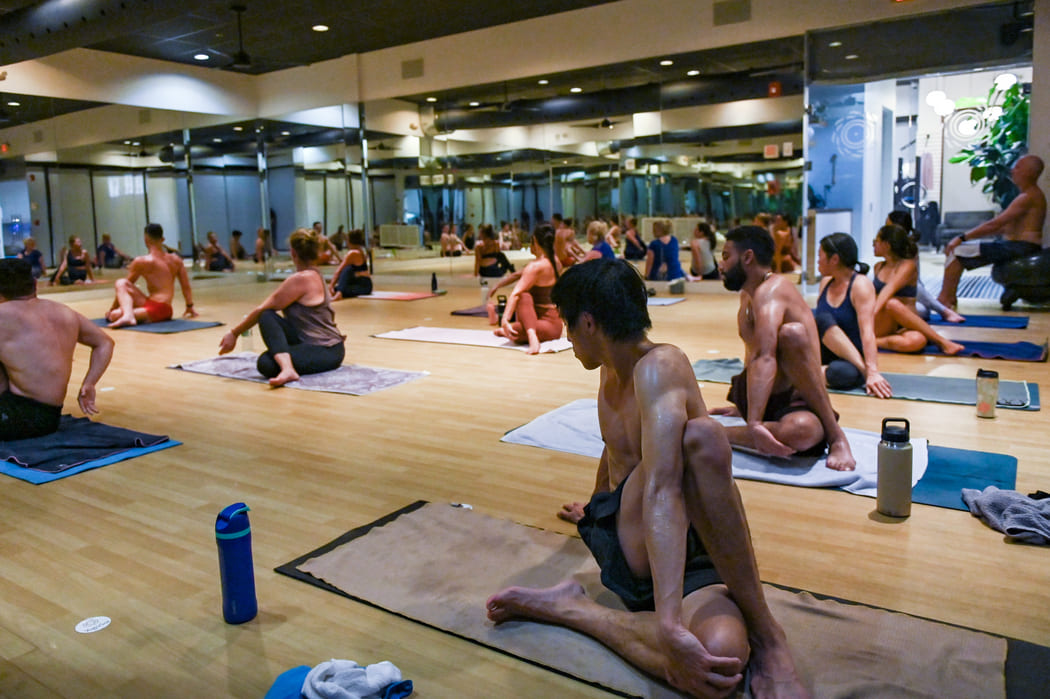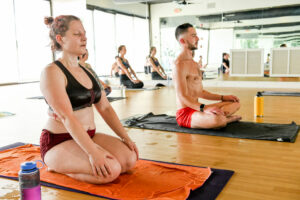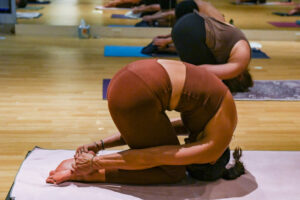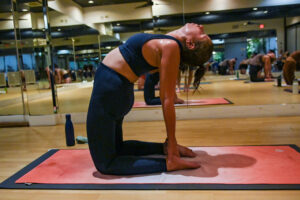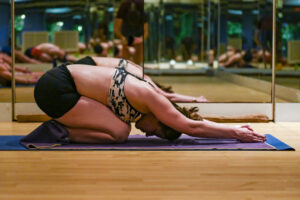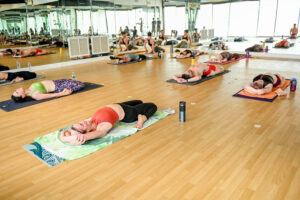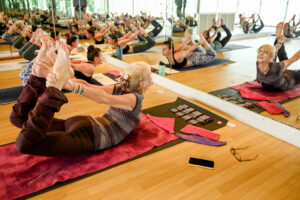Let’s slither into the world of the king cobra, a creature that effortlessly captures our attention with its serpentine grace and mesmerizing gaze. This majestic snake is like the rockstar of the animal kingdom, exuding power, elegance, and an air of mystery.
Now, you might be wondering how on earth a snake like the king cobra relates to yoga, of all things! Well, my friend, it’s in the heart of this majestic serpent that we find the inspiration for one of yoga’s most iconic poses – the Cobra Pose, otherwise known as Bhujangasana. But before we dive into the world of yoga, let’s get to know our slithering superstar a little better!
First off, the king cobra is quite the legend when it comes to striking fear into the hearts of many. It’s not just because of its jaw-dropping size, which can average a staggering 18 feet! Nope, this snake’s got more tricks up its hood. With eyesight that’s sharper than most of its snake buddies, it can spot movement from nearly 330 feet away. And that hiss? Well, it’s not your typical snake’s hiss; it’s more like a growling reminder of its presence!
Now, picture this: the king cobra is all about the lush streams tucked away in dense forests, hanging out in bamboo thickets, and even getting cozy in mangrove swamps. And guess what? It loves playing peekaboo from tree branches, surveying its domain like a watchful forest guardian.
But here’s where it gets interesting. This creature’s claim to fame is its venomous bite. When it strikes, venom from those specialized fangs hits the mark with surgical precision. The result? Paralysis, thanks to potent neurotoxins, and a rather gruesome process of digestion that starts within minutes.
So, you might be wondering, how on Earth does this all tie into yoga, that peaceful practice for body and soul? Well, it’s a bit of a twist, but stick with me. Despite the king cobra’s spine-chilling traits, the Cobra Pose represents overcoming fear. You see, in the heartland of India, there’s this profound belief that by facing our deepest fears head-on, we can break free from the illusion that fear casts over us.
So, as we embark on this journey to understand the Cobra Pose, we’re not just tapping into the king cobra’s grace and power; we’re exploring the connection between the world of yoga and the wild, a place where both the physical and spiritual realms seamlessly intertwine.
Ready to embrace your inner cobra?
Before diving into the Cobra Pose, here is what we will cover in this article:
What is Bikram Yoga?
Before we slither into Cobra Pose or Bhujangasana, let’s shed some light on Bikram yoga, also known as hot yoga. This unique style of yoga was founded by Bikram Choudhury and typically consists of a series of 26 challenging poses practiced in a heated room. The combination of intense heat and demanding postures makes Bikram yoga an unforgettable experience. But don’t worry; you’ll emerge from those classes feeling stronger, more flexible, and perhaps a bit like a fully charged battery
If you want to dive deeper into the world of Bikram yoga, check out this insightful article on the benefits and philosophy behind it.
Cobra Pose Sanskrit
In yoga, understanding the Sanskrit names of poses adds depth to the practice, reminding us of the ancient wisdom and spirituality that underlie each posture. “Bhujangasana” symbolizes the awakening of energy, the expansion of consciousness, and the shedding of old layers to reveal inner power and vitality.
The Sanskrit name for the Cobra Pose is “Bhujangasana.” In Sanskrit, “Bhujanga” means “snake,” and “Asana” means “pose” or “posture.” So, “Bhujangasana” translates to “Cobra Pose.” This name captures the essence of the pose, as it mimics the graceful arch of a cobra rising while keeping the lower body grounded.
Step-by-Step Guide to Cobra Pose
Now, let’s turn our attention to the star of today’s show: Bhujangasana, otherwise known as the Cobra Pose. In this pose, you’ll channel your inner serpent and discover a world of flexibility, strength, and rejuvenation.
Here’s how it’s done:
- Start the Dance: Begin by laying flat on your stomach, legs extended behind you, and your palms planted firmly beneath your shoulders. Keep your elbows close to your body.
- Inhale Like a Serpent: As you inhale deeply, slowly lift your chest and head off the mat while keeping your pelvis grounded. Imagine your upper body unfurling like a cobra rising from its basket.
- Eyes on the Prize: Gaze forward, keeping your neck long and relaxed. Don’t crunch your neck – maintain a sense of spaciousness.
- Sssstretch: Continue to press your palms into the mat, straightening your arms as much as possible. Your lower ribs should remain in contact with the floor.
- Hold That Pose: Maintain the Cobra Pose for 15-30 seconds or longer if you’re feeling particularly snake-like.
- Exhale and Descend: To exit gracefully, exhale and slowly lower your chest and head back down, returning to the starting position.
Modifications
Bhujangasana can be a challenging pose, but fret not! There are modifications to cater to all levels. Whether you’re a seasoned yogi or a first-time snake charmer, here are some variations to consider:
Baby Cobra: If you’re just starting, lift your chest only slightly off the mat. This lessens the intensity and allows you to focus on form and breath.
Sphinx Pose: For a milder backbend, rest on your forearms with your elbows directly under your shoulders. This variation provides gentle stretching for the spine.
Upward Facing Dog: Once you’ve mastered the Cobra Pose, you can progress to the more advanced Upward Facing Dog. In this pose, your thighs and the tops of your feet should be the only parts of your body touching the ground.
The Physical and Mental Perks of Cobra Pose
Now that you know how to get into the Bhujangasana, let’s explore its physical benefits.
Incorporating this pose into your Bikram yoga practice can do wonders for your body:
Spinal Flexibility: Cobra Pose is the ultimate spine stretch, promoting flexibility and relieving tension in the lower back.
Strengthens Back and Core: Regular practice of Bhujangasana strengthens the muscles along your spine, enhancing overall back and core strength.
Improves Posture: Embracing the Cobra Pose can help combat the slouching habits that come from a sedentary lifestyle. It encourages better posture and alignment.
Stimulates Organs: The gentle compression on the lower abdomen in Cobra Pose can aid digestion and stimulate the organs in your belly.
Enhances Lung Capacity: As you lift your chest and expand your ribcage, you also increase lung capacity, promoting better breathing.
Let’s not forget the mental magic of the Cobra Pose. This pose offers a myriad of mental benefits as well.
Stress Buster: The slow, deliberate movements of Cobra Pose combined with deep breaths can be incredibly calming, reducing stress and anxiety.
Focus and Concentration: Holding the pose requires concentration and mindfulness, helping you train your mind to stay in the present moment.
Energy Boost: Cobra Pose is a fantastic way to awaken your body and mind, leaving you feeling invigorated and ready to tackle whatever challenges come your way.
Emotional Release: Backbends are known for unlocking pent-up emotions. Practicing Bhujangasana may lead to emotional release and a sense of catharsis.
Self-Acceptance: As you bend and stretch in Cobra Pose, you learn to accept your body’s limitations and appreciate its unique abilities.
Embrace Your Inner Snake
In the world of Bikram yoga, Bhujangasana, the Cobra Pose, is a true gem. With its physical benefits, mental serenity, and variations to suit all skill levels, it’s a pose that can transform your practice.
So, don’t be afraid to embrace your inner snake, hiss away the stresses of life, and let Bhujangasana lead you on a journey to a healthier, more flexible, and fearless you. With each practice, you’ll slither closer to the harmony of body and mind that yoga promises, one serpent-like stretch at a time.
If you’re up for some yoga fun in a class setting, grab your spot in one of our upcoming Bikram 26 and 2 sessions!
FAQ:
Q: I’m a bit intimidated by the thought of practicing the Cobra Pose in a hot yoga studio. What if I can’t keep up with the experienced yogis?
A: Experienced yogis were once beginners too, so focus on your own progress and enjoy the process. You’re not expected to keep up with others; it’s about your own growth and comfort. Over time, as you practice, your confidence will naturally increase!
Q: I have a history of back pain, and I’m afraid the Cobra Pose might worsen it. What if it hurts?
A: If you have a history of back pain, it’s essential to approach yoga poses, including Cobra Pose, with caution. Listen to your body and communicate with your instructor about your concerns. They can provide guidance on proper alignment and modifications to ensure you practice safely and avoid exacerbating your back pain. Remember, yoga should be a healing and therapeutic experience, and with the right adjustments, you can work towards strengthening your back and reducing discomfort over time.
Q: I fear that others might judge me if I can’t hold the pose perfectly or if I need to take breaks.
A: It’s common to worry about judgment during yoga, but remember that yoga is a personal journey, not a competition! Focus on your breath and body sensations, modify poses or take breaks when needed, and ask for help from instructors. Surround yourself with a supportive community, and replace negative thoughts with positive affirmations. Your yoga practice is about self-discovery and self-acceptance, not the judgments of others.
 -ing our NEW! Community Classes!
-ing our NEW! Community Classes!
